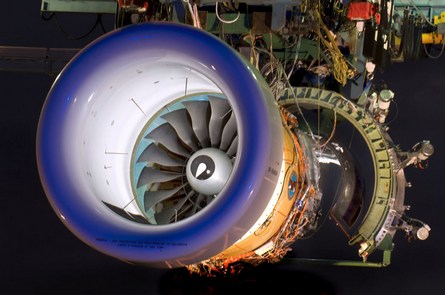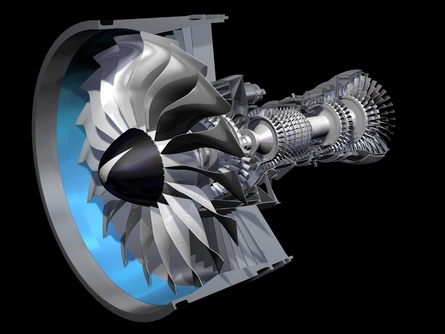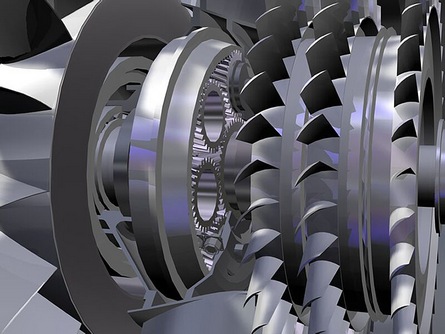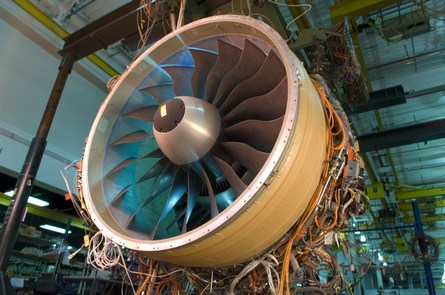Pratt & Whitney's greatest commercial-engine gamble in decades is now running on a test stand in Florida. P&W believes its GTF geared turbofan is a "game changer" that can address both the aviation industry's growing environmental challenge and the engine manufacturer's own eroding market share.
Two rolls of the dice have been lucky for P&W so far, with the GTF selected to power the Bombardier CSeries and Mitsubishi Regional Jet. Neither programme is formally launched, but if both are, the GTF will take pole position in the race to power the next generation of Airbus and Boeing narrowbodies.
P&W has already spent $1 billion over the past 20 years on geared turbofan research and development, and its spending is running at $100 million a year. But this will ramp up significantly if the CSeries and MRJ are launched as planned in 2008, and P&W begins development of a family of engines based around two sizes of advanced core and covering the 14,000-30,000lb (62-134kN) thrust range.
Technology readiness
The engine that began ground runs at P&W's West Palm Beach test site in mid-November is its GTF demonstrator, a key element in a technology readiness programme that is paving the way for a product launch in 2008. The demonstrator will complete around 100h of ground tests then be installed on P&W's Boeing 747 engine testbed for another 100h of flight tests beginning in May.

© Pratt & Whitney
Mitsubishi is aiming for a launch decision on the 70/90-seat MRJ by the end of March, while Bombardier is to decide on launching the 110/130-seat CSeries some time during next year. The MRJ will be powered by a 14,000-17,000lb-thrust GTF, while the CSeries engine will be rated at 23,000lb thrust and built around a larger version of the same advanced core. That larger core is also the basis of the GTF P&W is proposing to power the next-generation single-aisle airliners.
In a two-shaft turbofan the core, or high spool - high-pressure compressor (HPC), combustor and high-pressure turbine (HPT) - drives the engine. It powers the low spool - fan, low-pressure compressor (LPC) and low-pressure turbine (LPT). As gas leaves the HPT, the LPT extracts power to drive the fan, which produces most of the thrust.
Increasing the ratio of the air that goes through the low-pressure fan to that which goes through the high-pressure core - the bypass ratio (BPR) - improves propulsive efficiency. The engines powering today's narrowbodies have BPRs of 5-6, while new engines to power the Boeing 787 have BPRs of 10-11. Increase fan diameter to push up the bypass ratio and fan speed must be reduced to keep the tip speed down to minimise losses and noise.

© Pratt & Whitney
The GTF has a bypass ratio of 10-12, twice that of the CFM International CFM56 and International Aero Engines V2500 turbofans powering the Airbus A320 and Boeing 737. That is the major factor in the 12% reduction in specific fuel consumption projected for the GTF. The slower fan is also the biggest contributor to the predicted reduction in noise to a cumulative 20dB below Stage 4.
"The blades are big and the slower they turn the more efficient the engine is - and the slower the fan speed, the lower the noise," says Bob Saia, vice-president, next-generation product family. "If we can turn the fan slower, we can make the diameter bigger, and also make the HPC and HPT smaller because 80% of the thrust comes from the fan."
Decoupled Fan
But if fans work best when they turn slow, turbines work best when they turn fast. The larger and slower the fan, the longer and heavier the low-pressure turbine required to drive it. "Today, engine speed is a compromise between fan and LPT speed," says Saia. This is not the case in the GTF. "The fan drive gear system allows the fan to be decoupled from the LPC and LPT. The reduction gearbox allows the fan to turn at a third the speed of the LPT, and decoupling allows the LPT to run at a more efficient higher speed where it can do more work with fewer aerofoils."
An estimated 40% saving in maintenance costs is driven largely by the reduced parts count. Compared with a conventional engine, the LPT runs 2.5 times faster while the fan runs at two-thirds the speed. This has allowed P&W to remove 900 aerofoils in the LPT and 600 in the LPC, compared with the V2500. "A typical engine has 3,500 low-pressure compressor and turbine aerofoils. The GTF has around 2,000 - that's a 60% reduction," says Saia.
Weight offset
While the fan drive gear system adds complexity and weight, this is offset by the reduction in LP stages and airfoils, says P&W. Also, for a given thrust, the bigger fan means the high spool can be smaller, saving weight. "The GTF is 10% lighter than a conventional engine because it has fewer stages," says Saia. A 25,000-30,000lb-thrust engine would have a three-stage LPC, eight-stage HPC, two-stage HPT and three-stage LPT - down from six stages because of the high speed, he says.
The fan has 18 swept blades, compared with a typical 22-24, and this takes weight out of the fan system, Sais says. The demonstrator has conventional titanium fan blades, but P&W is studying both lighter metal and composite blades. Because the fan turns slower, there is not as much energy in the blades, he says, reducing the weight of the containment system.
As for the fan drive gear system, Saia says it is "a high-efficiency gearbox, so small in size that is does not drive weight up". There is a centre gear driven by the LP system, five stationary star gears and an outer ring gear to which the fan is attached. If weight is not a driver, reliability is and P&W has logged 10,000h of gearbox operation on a dedicated rig. "We have forced failures in the rig - misalignment, oil starvation, intentional gear wear - so we understand the design margins, production tolerances and wear tolerance."
P&W is on its sixth or seventh generation of gearbox, and the unit in the GTF demonstrator is the final generation for production readiness, he says.

© Pratt & Whitney
The gearbox rig is one of 15 in P&W's programme to get all the GTF elements to a technology readiness level of six before committing to launch the engine. The demonstrator engine is the final validation step. "We took the PW6000 core and built a product-relevant engine around it: the low turbine, low compressor, fan drive gearbox and fan module are close to production," says Saia. P&W's partners on the demonstrator are Avio for the fan drive gear system, MTU for the high-speed LPT and Volvo Aero for the turbine exhaust case. P&W supplied the fan and high-speed LPC while Goodrich has provided the slimline nacelle.
The demonstrator is a 28,000lb-thrust engine with an 80in-diameter (2.03m) fan and a 30,000shp (22,400kW) gearbox. The fan was sized to match the PW6000 core a 25,000-30,000lb-thrust engine for a next-generation single aisle, with advanced core and higher bypass ratio, would have a fan diameter of 75-78in, says Saia. This compares with 56in for the MRJ engine and 73in for the CSeries.
Scaled cores
P&W's plan is base the family of engines around two "photographically scaled" cores. All the elements of the advanced core are already in test, including the HPC at MTU, the combustor, and the HPT, which is in development for the V2500 SelectOne upgrade. The larger core for the CSeries engine is also the one that P&W is proposing for the next-generation single aisle.
"Our vision is to keep at two cores, but there is nothing to prevent us scaling up the core," says Tom Pelland, director, next-generation product family.
Launch on the CSeries and/or MRJ in 2008 would lead to engine certification in 2011, flight testing in 2012 and entry into service in 2013 - well ahead of any new narrowbody from Airbus or Boeing. The earliest a new single-aisle is expected is 2015, for which the engine choice is between an advanced turbofan and the GTF. But the airframers could wait until later in the decade to get a high-performing engine, which would pit the GTF against the open rotor.
P&W believes it can upgrade the GTF over time to keep it competitive, even against the open rotor. "We're in advance of Airbus and Boeing so we can cover early applications like the CSeries and MRJ, but we can add new technologies for 2015, 2018 or 2020," says Saia. "We have a pretty detailed plan that scopes technologies that would apply to the GTF - technologies that would support having better fuel consumption or lower maintenance cost."
Renewed interest in open rotors appears to be the biggest threat to the GTF gamble, but P&W plays it down. "We are benchmarking our GTF offerings to an advanced turbofan as well as an unducted fan so we understand them, and the unducted engine has some very high hurdles that need to be understood," says Saia. "Fan diameter for a 25,000-30,000lb thrust-class GTF is 75-80in. When you go unducted that almost doubles, to 12-15ft in diameter."

© Pratt & Whitney
P&W accepts that an uninstalled open-rotor engine offers lower specific fuel consumption, but questions how much of that benefit will be lost in installation. "Comparing the two engines running side-by-side stationary in a test cell, the unducted version will give you lower fuel consumption, in the 3-5% range. But when you install the unducted fan the pylon has to be longer, which adds a lot of weight," he says. "If it's under the wing, you need longer landing gear." Aft-fuselage mounting requires the fuselage to be strengthened because of the extra weight at the back and wing mounting requires more insulation in the fuselage, he says.
"GTF allows us to get near open-rotor engine efficiency. Having the outer duct allows us to add acoustic treatment, and we can make the fan diameter larger so we slow the fan down and get quieter," Saia says. "It's hard for me to believe that the industry or the world will relax noise limits around airports, and with the geared fan you can get open-rotor fuel efficiency without sacrificing any noise reduction." Pointing out it has taken P&W 20 years to develop the GTF, he questions how long it will take for open rotor or an all-new aircraft architecture. "We still don't know how they can overcome the hurdles."
Geared turbofans are not new - Honeywell's TFE731 business-jet and LF507 regional-jet engines have geared fans - but the GTF can produce much more thrust and its fan drive gear system must transmit much higher power, with low weight and high reliability. P&W is developing the GTF to cover the 14,000lb to 30,000lb thrust range, to power aircraft ranging from large regional jets to single-aisle airliners.
No widebody - for now
The widebody market is not a GTF target - for now. "The next widebody aircraft is probably post-2020," Saia says, but adds there is "no reason why we cannot grow to a bigger engine". The MRJ, meanwhile, "is just on the lower end of the value a geared fan will bring". Business jets will not go GTF, he says. "They fly fast at high altitude, which defines an engine architecture with a 5 to 7 type bypass ratio."
But the glittering prize is the next-generation single-aisle market. Pelland says P&W's preferred route to that market is through its partnership in IAE, where talks are already under way. The GTF faces competition from an advanced turbofan proposed by Rolls-Royce, but Pelland says a decision does not have to be made immediately, as it is tied to Airbus and Boeing defining their requirements.
IAE backed the geared turbofan once before, when Airbus selected the ultra-high bypass SuperFan for the A340 in 1986 only to see the consortium cancel the engine because of the risk that the technology would not be ready in time. Two decades on, P&W has ensured the technology will be ready. Now the company must wait to see if the market is too.
Source: Flight International



















